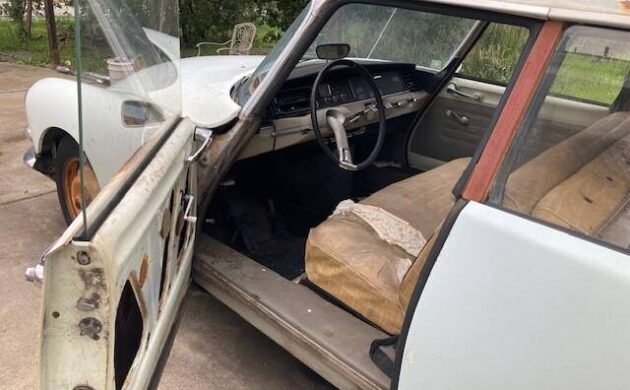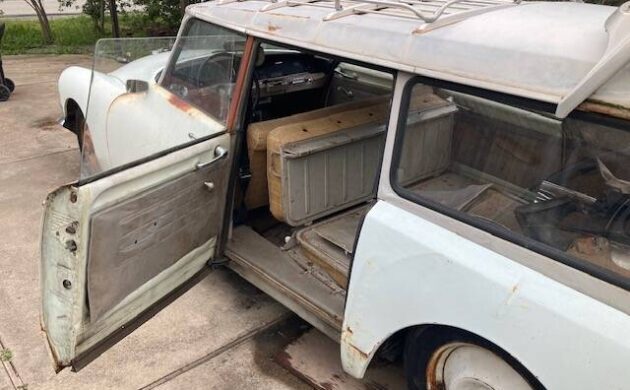The Citroën DS and its variants were built between 1955 and 1975, with worldwide sales that approached 1.5 million units. You commonly see them in international films, but not that often in person in the U.S. The ID19 was a lower-priced version of the DS, and the estate or safari version (aka station wagon) is what the seller has to offer. These automobiles were highly innovative in their design and execution, especially in terms of suspensions. From an estate sale in Mountain View, California, this wagon is available here on craigslist for $6,500 OBO. Another cool find by T.J.!
These automobiles are noted for being innovative and ahead of their time. The DS (and ID variant) had a hydro-pneumatic, self-leveling suspension using nitrogen gas springs over hydraulic jacks for each wheel, which adds up to one of the smoothest rides ever built. The built-in shocks are said to never wear out. And the vehicles have power disc brakes using an engine vacuum-powered booster with stored hydraulic power that can deliver multiple panic stops with the engine deactivated.
Though the DS19 was first introduced in 1955, the less expensive ID19 came out two years later (the French were still recovering from the economic effects of World War II). They had the same bodies and many of the same features but were less powerful and not as luxurious. These cars were on the U.S. market until 1972, never big sellers as the American buying public wasn’t as taken by their design innovations as the French were. After selling 38,000 variations over the U.S., Citroën pulled out of the market.
The seller’s car is offered as part of an estate and is being listed by an expert in the cars, someone with 63 years of self-proclaimed experience. The engine runs, but the car does not stop so it will need to be transported by truck or flatbed. The interesting suspension is said to be intact and will hold a “charge” for up to three days. These engines can be hand-cranked, but also have a starter and this one has been rebuilt. The carburetor will need to be cleaned and the exhaust header reconnected to the exhaust, so a bit more work will be needed beyond the brakes.
Body-wise, there are a few little dents and dings, but the panels are removable for repair. Some of the inner wheel-well covers need to be re-installed as do the rubber parts of the suspension. Despite their lack of sales in the U.S. back in the day, apparently getting parts isn’t as hard as you might think, thanks in part to what the seller says is a strong network of local and national clubs for these automobiles. Once you get it back on the road, the 1900cc engine should deliver about 25 mpg. What’s not to love?







I’d buy this and then run for President of the Home Owner’s Association board in a gated community…
What is it, World Citroen Day? Excellent news! ID/GS/BX.
Allez les Bleus!
Also, the spheres – on green blood cars, at least – do wear out. Takes a while, but you can see it; if a car looks “choppy” on the motorway, it’s a sign that the spheres need replacing. Inside, it feels bumpy and uncompliant. I’ve never owned or worked on a red blood hydropneumatic Citroen.
The suspension gas springs or spheres do lose nitrogen over time, but with a good home-made high pressure valve, they can be recharged easily off a low cost rented nitrogen cylinder.
One correction here – the brakes are not vacuum-assisted. The Citroen system has a straight high pressure hydraulic power system supplying the steering, brakes, suspension and the shifting in the semi-automatic gearshifting of the basically manual transmission. The brakes do not get power from the typical engine-vacuum boosted power brakes. Citroen brakes have a pressure storage sphere, along with a pressure regulator sphere, both of which can feed power into the brakes even when the engine fails. Multiple hard stops can be made if one experiences engine failure on the road in the Citroen. With vacuum-boosted brakes, one typically gets maybe one stop or NONE when the engine fails during driving.
Autism on wheels. To the crusher.
Philistine! On a long weekend with four big adults and their luggage, I drove from Santa Ana to Morro Bay round trip and got 32mpg. My last DJF 21 Safari became steam powered in 1973 and is in a collection in Berrien Springs, Michigan.
Yawn. Not compelling enough to overcome that horrific design.
I’ll bet you own a Rambler Marlin
I don’t, but the Marlin is a far superior design.
As long as it’s not rusty, this would be a great project for an amateur restorer, preferably one familiar with Citroens. For others, that 2CV parked next to it would be a much better choice!
We had a white Safari in the 70s when I was a kid growing up. The kids on my lane nicknamed The Noodle”. Everybody loved it and it was a decent runner. My father, then bought a maroon and silver Polaris, which was that named “The Super Noodle”. Everyone loved how you could raise and lower the cars with the hydropneumatic suspension. We also had a Mehari at the same time, the plastic little jeep they made. Of all the cars we have her owned, my mother loved that was the best! No accounting for taste!!!
Pallas…not Polaris….
I bought it. Well represented. Solid car, needs the usual stuff you’ll need to do for an early Citroen, but no rust other than some flash. Stoked.
Panels are straight and easy to shape. As all the doors and panels are easily removable one has good access if rust repairs are needed. Hydraulic pipes are also easy to replace. I regret selling mine as is where is with no time to do anything.
A friend of mine yrs ago who owned an early ID19 wagon told me he and his brother were driving one night. The brother had fallen asleep as the car’s ride is so smooth at any speed it almost lulls you to snoozing. At one point after the brother woke up, the driver asked him how fast he thought they were going. The sleeper said “70?” The driver responded -“no, we’re running 100 mph” These cars in norrnal good condition ride so smoothly at speed that it is sometimes hard to tell how fast they’re going. I routinely drove my ’59 sedan at 90 when traveling to school in California from Utah. It’s tremendously powerful 1900 cc hemi engine – all 65 hp – took awhile to get going, but loved running at above average speed. And gave 27 mpg at that mph.